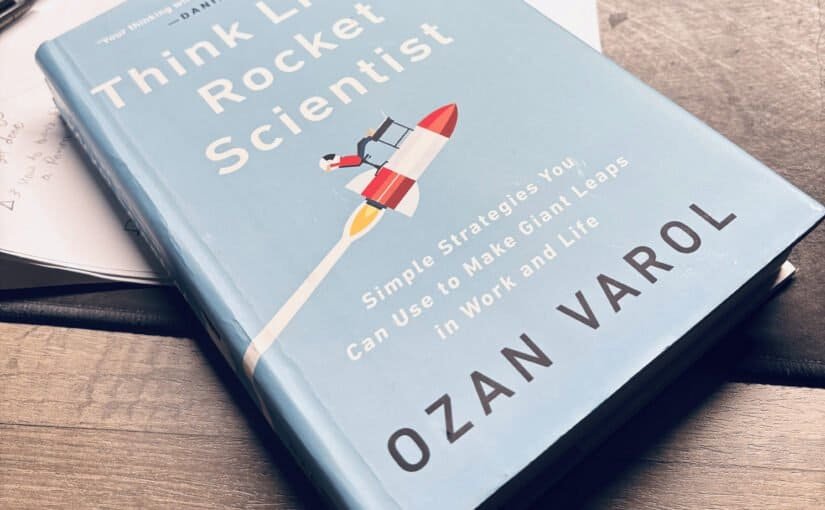Contents
Introduction
In Think like a Rocket Scientist, Ozan Varol unpacks the mental models and problem-solving strategies that fuel innovation in rocket science—and shows how they can be applied to everyday challenges. The book argues that breakthroughs don’t come from following conventional wisdom but from questioning assumptions, embracing uncertainty, and thinking in first principles. Varol draws on historical anecdotes, scientific discoveries, and practical insights to demonstrate how moonshot thinking can drive success in business, technology, and life. Through engaging storytelling and thought-provoking ideas, Think Like a Rocket Scientist challenges readers to reimagine obstacles as opportunities and develop a mindset that welcomes experimentation, creativity, and intelligent risk-taking.

If you’d like to purchase the book on Amazon, please follow the links below:
1) Paperback
2) Hardback
Embracing Uncertainty
Progress is inherently uncertain, and great discoveries happen when we navigate the unknown. We often search for answers in the familiar (the “street lamp” fallacy), but true breakthroughs come from questioning assumptions and analyzing anomalies. Varol highlights the importance of stress-testing ideas, using redundancy for risk management, and adopting a mindset that values learning from failure over avoiding it.
First-Principles Thinking
Instead of reasoning by analogy, which limits creativity, first-principles thinking breaks ideas down to their core truths. By stripping away assumptions and rebuilding solutions from the ground up, we can unlock revolutionary innovation. This approach helped SpaceX reinvent reusable rockets when conventional wisdom deemed them impossible.
Thought Experiments and Playfulness
Creativity thrives in a state of relaxed exploration. Nikola Tesla and Albert Einstein relied on mental simulations before executing their ideas. Hustle culture often stifles breakthrough thinking—true innovation requires designated time for reflection and imaginative problem-solving.
Moonshot Thinking
Most people play not to lose rather than playing to win. To achieve the impossible, we must think beyond incremental improvements and aim for radical leaps. The key to moonshot thinking is questioning self-imposed constraints and adopting a divergent mindset that explores absurd yet potentially transformative ideas.
The Power of Reframing
The best solutions emerge not from answering a question but from asking a better one. By shifting perspectives and challenging initial problem definitions, we uncover new paths. The book underscores the importance of questioning existing strategies and finding counterintuitive approaches to solving challenges.
Thinking in Opposites and Stress-Testing Ideas
Confirmation bias causes us to look for evidence that supports our existing beliefs. Instead, we should actively challenge our ideas and consider opposing perspectives. Great thinkers, from Karl Popper to Richard Feynman, emphasized the power of falsifiability—progress happens when we try to prove ourselves wrong rather than right.
Experimentation and Learning from Failure
Innovation is built on iterative testing. “Test as you fly, fly as you test” is a core principle in rocket science—real-world experimentation trumps theoretical perfection. Failure isn’t an endpoint but a stepping stone. Intelligent failures, where we take calculated risks and extract insights, accelerate learning and progress.
The Paradox of Success
Past success can breed complacency, leading to catastrophic failures. The most successful individuals and organizations continuously question their wins, analyze near-misses, and remain adaptable. Overconfidence in previous successes can create blind spots—true progress requires staying curious, humble, and open to change.
Conclusion
In Think like a Rocket Scientist, the key message is that thinking like a rocket scientist means embracing uncertainty, challenging assumptions, and daring to attempt the impossible. By applying first-principles thinking, fostering creativity, and learning from failure, we can push the boundaries of what’s possible—not just in science, but in every aspect of life.
If you’d like to purchase the book on Amazon, please follow the links below:
1) Paperback
2) Hardback
Related Reviews
- Review of The Creative Act by Rick Rubin
- Review of The Art of Clear Thinking by Hasard Lee
- Review of Think Like a Rocket Scientist by Ozan Varol
- Review of Same as Ever by Morgan Housel
- Review of The Upside of Uncertainty by Nathan Furr
Author:
